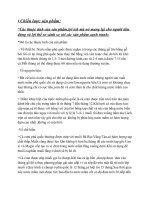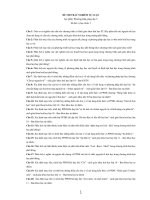Đề cương trắc nghiệm tự luận Kinh doanh quốc tế (International Business)
Bạn đang xem bản rút gọn của tài liệu. Xem và tải ngay bản đầy đủ của tài liệu tại đây (73.85 KB, 8 trang )
STAFFING POLICY
- Polycentric approach: Hiring local managers. (reqiures host-country nationals to
be recruited to manage subsidiaries, while parent-country nationals occupy key
positions at corporate headquarters. In many polycentric approach is a response to
the shortcomings of an ethnocentric approach. One advantage of adopting a
polycentric approach is that the firm is less likely to suffer from cultural myopia
(cận thị). A second advantage is that a polycentric approach may be less expensive
to implement, reducing the costs of value creation.)
- Geocentric approach: Hiring people for their skills. ( seek the best people for key
jobs throughout the organization regradless of nationality.)
- Ethnocentric approach: Hiring managers with the same nationality. (is one in
which all key management positions are filled ny parent country nationals.)
Staffing: the selection of employees who have the skills required to perform a
particular job
Training: preparing the manager for a specific job.
***
1. What does International Business refer to?
- It refers to all commercial activities, private or governmental operated in two
countries or more.
2. Explain what GLOBALIZATION means?
- Globalization refers to the shift toward a more integrated and independent world
economy. People and countries can exchange information and goods more quickly
and in a less complicated way.
3. What is the different of Globalization and Localization?
Globalization
Localization
DEF: The tendency toward an
international integration of goods,
technology, information, labor, capital, or
the process of making this integration.
DEF: The process of adapting a
product or service to a particular
culture, language, developing a local
appeal and satisfying local needs.
Undifferentiation and convergence in
customer preferences and income across
target
countries
with
economic
development and trade; takes into account
mass demand; quantity; international
brand awaremess; cost benefits from
stradardization.
Defferences in customer preferences
and income across target countries;
takes into account specific demand;
localism; quality and values; local
brand recognition; competition from
both successful local products and
international brands.
4. A MATRIX Organization
DEFINITION:
ADVANTAGES:
DISADVANTAGES:
A company structure in
which the reporting
relationships are set up
as a grid, or matrix,
rather than in the
traditional hierarchy
1. Access to expertise.
1.
Confusion
command.
of
2. Stability of permanent
departments
for 2. Power stuggles and
employees.
conflicts.
3. Allows for focus on 3.
Lost
time
in
specific
projects, coordinating.
products, or customers.
4. Excess overhead for
managing
matrix
functions.
3. What does cross-cultural literacy mean?
- Individuals and firms must develop cross-cultural literacy.
- International businesses that are ill informed about the practices of another culture
are unlikely to succeed in that culture.
- Individuals must also beware of ethnocentric behavior (a belief in the superiority
of one's own culture).
4. When business people talk about the growing middle class of emerging
markets, is it an opportunity or threat in International Business? Explain.
-
5. Why is a Free Market Economy important if a foreign business wants to
enter that market?
- Supply and demand is the economic model of how prices are determined in a
market. Demand for goods refers to pressure in the market from people trying to buy
it. ... That means that the lack of barriers with little or no entry costs helps
competition thrive in a free market economy.
TRUE or FALSE
6. Exporting is often the first international business activity a firm does? (True)
7. Acquisition is the cheapest way of an international business expansion? (False)
8. If a firm is slow to enter a country, it means that no competitors have already
entered that foreign market? (False)
9. If a firm is fast to enter a foreign market, it means that it's the first company to
enter that market? (True)
10. According to sociologists, there is a strong presence of Confucianism in China the philosophy that was taught by Confucius over 2,000 years ago. However, it still
has an impact of today's Chinese society, which makes it more of a "RelationshipOriented culture" than a "Deal-Oriented culture". (True)
11. A global standardization strategy relies on the production and the sales of a
product with the same attributes worlwide. A localization strategy relies on the
production and the sales of a product for which the attributes are adapted to the local
market. (True)
12. International Business only refers to private commercial transactions between
more than two countries. (False)
13. A standardized advertizing strategy means using the same messages, ideas and
aesthetics in all advertisement campaigns across the globe. (True)
MULTIPLE CHOICE
14. Tick all that is true.
A. Culture means habits and values people have.
B. Culture includes the food people eat, the clothes they wear, the religion they may
practice, the language they speak and maybe also their sense of humour.
C. Culture may not be the most important factor of an International Business
decision, it's a key element of International Business management.
D. All of the above.
15. What is the main disadvantage of wholly owned subsidiaries?
A. they make it difficult to realize location and experience curve economies.
B. the firm bears the full cost and risk of setting up overseas operations.
C. they may inhibit the firm's ability to take profits out of one country to support
competitive attacks in another.
D. high transport costs and tariffs can make it uneconomical.
16. What is the FDI Confidence Index? Answer all that is TRUE.
A. It's an annual survey.
B. It tracks political, economic, and regulatory changes that can impact on foreign
direct investment.
C. CEOs, CFOs and other top executives of Global 1000 companies may refer to it
for their international business decisions.
D. It's the Family Dummy Index. It tells you which families are the dummest.
17. _______ refers to the time and effort spent learning the rules of a new market.
(Pioneering costs)
18. All of the following are advantages of acquisitions except
A. they are quicker to execute.
B. it is not easy to realize synergies by integrating the operations of the acquired
entities.
C. they enable firms to preempt their competitors.
D. they may be less risky.
19. For businesses, considering ethics is important because... (ANSWER ALL
THAT IS TRUE.)
A. it shows how good or bad a company is.
B. it's part of the reputation a company has.
C. it will help reduce the costs of production.
D. justice may question companies if they don't follow ethics.
20. A strategic alliance means
A. choosing an international business partner that shares the same business
objectives.
B. that will offer the possibility to set-up a win-win partnership.
C. choosing a partner that will share its knowledge and skills.
D. all of the above
21. You book a room on the website of a famous international hotel chain. As
you arrive to check in, its reassuring brand name is above the door. Its logo is
everywhere: on the staff uniforms, the stationery, the carpets. But the hotel is
owned by someone else—often an individual or an investment fund. But what is
the nature of the business that the owner of the hotel has?
A. A licence.
B. A fully-owned subsidiary
C. A franchise.
D. A joint-venture.
***
- Six different ways to enter a foreign market: exporting, turkey projects, licensing,
franchising, establish joint vantures with a host country firm, setting up a new wholly
owned subsidiary in the host country.
Entry
Modes
Exporting
Jointventures
Acquisition
Definition
Disavantages
- High transport costs
Selling goods
-Ability to realize location and - Trade barriers
to
another
experience curve economies
- Problems with local marketing
countries
agents.
Sharing
business
Buying
= Turnkey business
contracts
Subsidiary
Advantages
- Lack of control over technology
- Access to local partner’s knowledge.
- Inability to engage in global
a - Sharing development costs and
risks.
- Polotically acceptable
a
strategic coordination.
- Inability to realize location and
experience economies.
- Ability to earn returns from process - Creating efficient competitors.
technology skills in countries where - Lack of long-term market
FDI is restricted.
presence.
- Protection of technology.
- Ability to engage in global strategic
= Wholly Not sharing a coordination.
- High costs and risks
business
owned
- Ability to realize location and
subsidiaries
experience economies.
- Very similar to those of licensing.
- Typically asumes those costs and
Franchisin
g
Allowing
- Lack of control over quality.
another
risks.
- Inability to engage in global
partner to use - A service firm can build a global
strategic coordination.
brand name
presence quickly and at a relatively
low cost and risk.
- Lack
Licensing
Allowing
other people
- Low development costs and risks
to use your
invention
of
control
over
technology.
- Inability to realize location and
experience curve economies.
- Inability to engage in global
strategic coordination.
ENTRY MODES
- Market Segmentation refers to identifying distinct groups of consumers whose
purchasing behavior differs from others in important ways. Markets can be segmented in
numerous ways: by geography, demography (sex, age, income, education level,…),
sociocultural factors (social class, values, religion, lifestyle choices), and psychological
factors (personality).
A joint venture entails establishing a firm that is jointly owned bt two or more otherwise
independent firms.
In a wholly owned subsidiary, the firm owns 100% of the stock.
Franchising is similar to licensing, although franchising tends to involve longer-term
commitments than licensing









